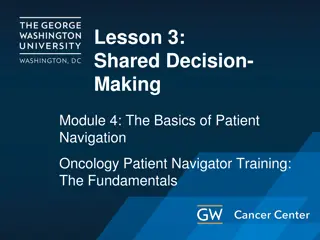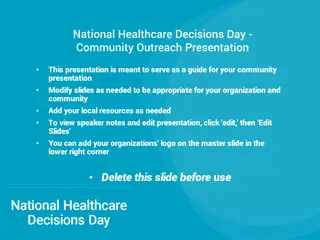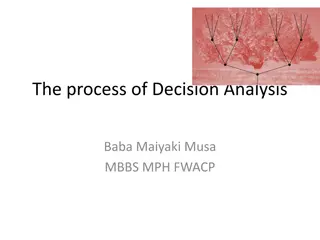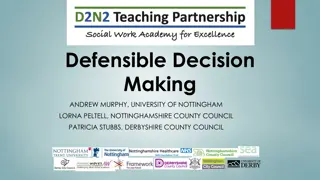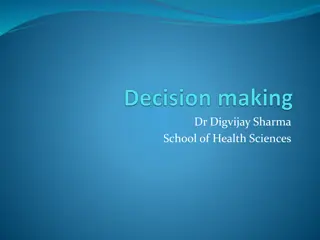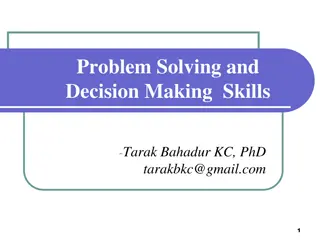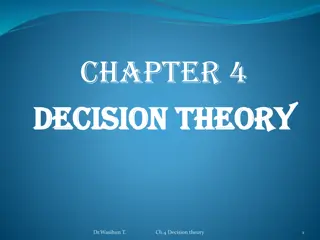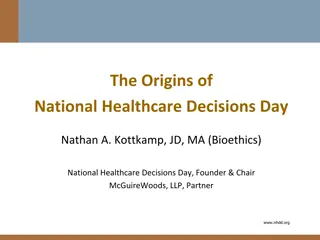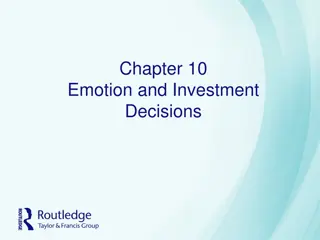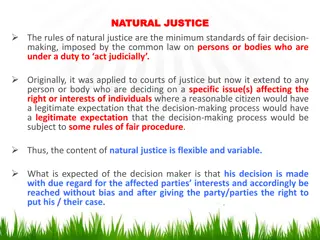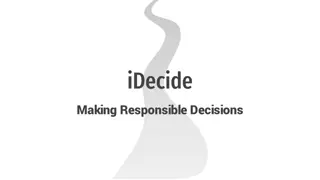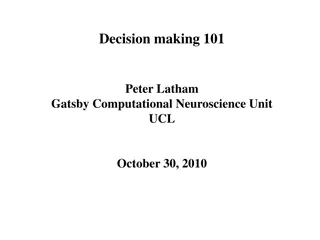The Impact of Shared Decision Making on Healthcare Decisions
Shared Decision Making (SDM) is a transformative approach that empowers individuals, including those with mental health challenges, to be actively involved in decisions about their care. Studies show that SDM enhances knowledge, participation, and satisfaction among patients, ultimately improving healthcare outcomes. Key assumptions highlight the value of individual expertise, while key facilitators emphasize the importance of readiness and evidence-based practices in fostering successful SDM implementation.
Download Presentation

Please find below an Image/Link to download the presentation.
The content on the website is provided AS IS for your information and personal use only. It may not be sold, licensed, or shared on other websites without obtaining consent from the author. Download presentation by click this link. If you encounter any issues during the download, it is possible that the publisher has removed the file from their server.
E N D
Presentation Transcript
Shared Decision Making (SDM) as a Turning Point Shulamit Ramon and Sarah Rae University of Hertfordshire Cambridgeshire and Peterborough Foundation Trust 10thMay 2019 s.ramon@herts.ac.uk sarah.rae@rockyroad.org.uk
Key Assumptions SDM began with a focus on physical ill health, and slowly started to include mental ill health too. It is based primarily on the assumption that people, including those who experience mental health problems, are expert in their own experience, on which they base their interventions preferences. It would be useful for clinicians to have access to this unique knowledge, no less than it would be for service users to have access to clinicians more scientific knowledge. Ethically, people should be involved always in decisions that affect them (Deegan and Drake, 2006). The concept of personal medicine (Deegan, 2005) The value of the ability to agree not to agree.
Impact The current verdict of SDM impact is promising. The MAGIC (Joseph-Williams et al, 2017) (Making good decisions in collaboration) programme in NHS sites in Newcastle and Cardiff confirmed that strategies to enhance the delivery of shared decision making can improve: People s knowledge about their condition and treatment options People s involvement in their care People s satisfaction with care People s self-confidence in their own knowledge and self-care skills Professionals communication
Impact II Durand et al (2014), who carried out a systematic review on SDM, report that: The narrative synthesis suggested that, overall, SDM interventions increased knowledge, informed choice, participation in decision-making, decision self-efficacy, preference for collaborative decision making and reduced decisional conflict among disadvantaged patients. Further, 7 out of 19 studies compared the intervention s effect between high and low literacy groups. Overall, SDM interventions seemed to benefit disadvantaged groups (e.g. lower literacy) more than those with higher literacy, education and socioeconomic status. Interventions that were tailored to disadvantaged groups needs appeared most effective.
Key Facilitators The readiness of most service users and of some clinicians to engage in SDM. Learning from relevant developments of SDM in the context of physical ill health Increased interest of policy makers in SDM The existing evidence that SDM works and does not harm We need to be clearer what is it that this majority of service users find useful and of value in SDM? Underlying reasons for exercising choice without informing the provider not impulsive
Key Barriers Many providers continue to argue that while they are focused on healing, the person s preference is focused wrongly , due to lack of insight. Insight here means accepting the provider s version of what underlies the mental ill health and what would constitute good interventions in specific cases. Attitudes to risk taking: fear of taking any risk, including positive, calculated, risk. In the societies in which we live, scientific knowledge is preferred on experiential knowledge in the context of decisions which call for expertise on complex decisions, on the assumption that the statistical knowledge accumulated on relevant populations uncovers the most accurate knowledge we can obtain. The frequent use of experiential knowledge in key life decisions is thus ignored. Compared to clinicians, in most studies concerning attitudes to SDM, more of the service users population wish to have SDM in the services they use. The minority that does not wish to be engaged in SDM states that it prefers to rely on providers decisions, presumably on the assumption that the latter know best, and that they, the patients, do not have anything of value to contribute to the process of intervention decision making or the final decisions.
The Illuminative use of Videos In 2012 we created a number of video scenarios of problematic shared decision making situations aimed at leading to group discussions among both service users and providers groups, as part of a funded study on introducing SDM in the management of psychiatric medication to an NHS UK trust (Ramon et al, 2017a, Ramon et al, 2017b). This project is one of two projects we know about where service users are equal partners to the training of SDM (Simmons et al, 2016). The scenarios were based on real life situations (changed for confidentiality) and enacted by professional actors, on the assumption service users might find it difficult and/or distressing to enact their own life situations. We used these scenarios in the project, but found that providers were more likely to engage in these discussions than service users. The latter would bring their own real life situations to the groups, not so much for discussion as for affirmation that their views should have been considered worthy of being accepted in comparison to prescribers views, once a relationships of trust and respect has been established.
Second Set of Videos In September 2018, we (service users, Shula, myself and two psychiatrists who practiced SDM) made a series of videos focused explicitly on positive SDM from the perspectives of service users in one trust. Although we proposed as before to ask actors to play the roles, nearly all of the service users participants at the introductory project meeting expressed vocally their view that they should be talking about their own positive experience, and that the use of the actors would not render their authentic perspective. We accepted their preference, and five of them volunteered to share their personal experiences of SDM. These five included people with different diagnoses and interventions experiences. Five women attended the initial meeting, though the two psychiatrists were men. I am not sure what to read into this gender difference.
Aim of the Videos The aim was to understand which key elements in these examples of good of SDM made the process and the outcomes positive for people with serious mental health challenges who had received services. These benefits also extended to carers and providers. To develop an intervention for training those mental health professionals (MPH) who find the SDM process more challenging. To capture the authentic voice of people with lived experience as this has not been the focus of existing studies. MPHs commonly report barriers to engaging with positive SDM in high risk situations. We were also keen to demonstrate how recovery can be practiced in high risk scenarios to reduce negative risk taking.
Positive Aspects of SDM: Service Users Perspectives: Emily A few years ago Emily experienced a series of crises and on one occasion ended up going to A&E. She felt that medication was contributing to these terrifying experiences and subsequently became very scared of taking medication. Emily identified that her symptoms of anxiety and depression seemed to be linked to her menstrual cycle. She discussed the contraceptive pill with her GP but taking it tipped her into crisis again. The turning point or life saving moment in Emily s journey was when a psychiatrist (accompanied by a junior doctor and a crisis team member) visited her and her partner at home. He was really good at listening and importantly, chose to sit on the low sofa rather than the higher chairs which Emily felt changed the power dynamic in a positive way. The psychiatrist validated Emily s fears (you re right to be scared of taking medication) but she still felt reassured by what he said.
Emily (continued) He took time to tell her about another type of medication, in a different class, explaining about the low risk of adverse effects and how it might help with eating and sleeping. Emily stressed how much she valued being taken seriously, the psychiatrist s kindness and the importance of being offered choice. She appreciated his honesty and willingness to admit that he didn t have all answers. When Emily had a specific question the psychiatrist asked the trainee doctor to obtain the information which she received shortly afterwards. She had a choice and decided to try the medication which she is still taking. The clinicians body language conveyed their attentiveness. Emily sensed there was no need to rush and that she and partner could say what they needed to say which gave her a glimmer of hope afterwards. Emily continues to do well. She trained and works as a Peer Worker, delivers training at the Recovery College East and has been involved in several research projects.
Jasmine Jasmine, aged 27, has experience of severe borderline personality disorder. She had had a high number of admissions due to suicide attempts. She was offered the possibility of staying in a special closed ward where patients stay for a year to enable her to live independently afterwards in the community. Jasmine accepted the offer, as she was unhappy too about her repeated admissions and the regime in the wards she was hospitalised in. Once she agreed, the compulsory order under which she was hospitalised was removed by the ward s consultant psychiatrist. He explained that they do so with every patient, in order to give a very clear message that residents of the ward are responsible for their own actions, including leaving the ward and coming back. When asked specifically about this high risk taking action, he acknowledged the calculated risk involved, but approached this specific step as a necessity in building up a different relationship from previous relationships they had in other wards between the clinical team and the person. For Jasmine, the removal of the compulsory admission the first turning point in understanding that the experience on the ward, and her role in it, would be very different from the much more rigid regime she has experienced on other wards.
Jasmine (Continued) She revelled in becoming responsible for her own action, admired the other residents who became her role models, and in the ward s atmosphere where having coffee with the staff was both a social occasion, as well as one for making shared decisions. Jasmine attended weekly DBT individual sessions as well as group sessions, and in one of these sessions it was suggested to her that when she feels tense and about to cut herself to relieve the tension she can try and put a small ice block on the place she intended to cut. She tried it, and to her amazement, it worked. She was elated, and has never cut herself since. The learning that she can control her self-destructive behaviour was another turning point. Jasmine made the decision when to leave the ward, where she was going to live, and which activities she will take up when she leaves. She did consult the staff, as well as some of the other residents, in making these decisions. She is very proud of recently attending a conference on personality disorder and speaking there of her experiences to the 300 participants.
Joana Joana is a woman in her 40s, who came to the UK from an EU country on her own, went to university in the UK, but did not finish her degree due to experiencing a psychotic episode. She has been on medication ever since (more than 10 years ago). Following her prolonged recovery from that experience she became a mental health advocate, working successfully in an early intervention centre for young people. She has been also in psychotherapy, and has an unspecified physical problem, for which she is has been treated over a long period. Two years ago, she married the boyfriend she had lived with for a couple of years, and both of them wanted to have children. Once she knew she was pregnant, J began to consider if she should/should not stay on medication during the pregnancy. She was advised by both the psychiatric and the perinatal teams to continue to take her antipsychotic medication, as they were afraid of the pregnancy generating another psychotic episode.
Joana (continued) Against their advice, she and her partner decided to discontinue the medication during the pregnancy, being afraid that the baby would be born with a drug dependency. Joana continued to be in psychotherapy during the pregnancy, as well as in the care of the perinatal team. In parallel, the service in which she worked as an advocate was taken over by another provider; she felt badly about this change. Two days after the baby was born, with no drug dependency, J began to re- take her psychiatric medication. That meant not being able to breastfeed her baby, yet she was keen to ensure the baby would be fed by breast milk. With the help of the perinatal team she has managed to secure a supply of fresh breast milk for the baby for six months, most of the time paying for it herself. The baby is doing very well, and J credits it to the breast milk and the lack of drug dependency. She is doing well too, becoming noticeably more slim than before, enjoying looking after the baby, while considering what she would like to do once her prolonged maternity leave comes to an end.
Joana (continued) She managed to remain in good relationships with both the psychiatric team and the perinatal team. For her the decision to stop taking medication during the pregnancy, and the decision to retake it soon after giving birth, were important steps of working out for herself and her partner their priorities and the risks she was consciously taking. She was, and remains, confident that she took the right decisions at each stage, inclusive of not trying to hide what she was doing from her service providers, just repeating her argument as to why she was making this decision. J took pleasure in being able to provide a cogent argument, and in the baby doing so well. The fact that she was supported by her partner and her psychotherapist in terms of her right to make the decisions no doubt added to her strength, and the very fact that she has not had any psychotic episode as a result of stopping the medication has added to her sense that her decision was the correct one. Shared decision making in Joana s case was more one of agreeing to disagree, without leading to acrimony and with both the person and the two teams working with her being ready to accept her right to make the decisions.
In Summary The examples highlight not only the capacity of people to participate well in shared decision making even after a prolonged career as a mental patient, but also the value of SDM as a turning point in enabling a much higher degree of self responsibility to be undertaken, and the value of this emancipatory, if demanding, experience of sharing power. The technology of SDM is very simple, and is based on respect, trust, listening, and shared knowledge. The time necessary to successfully establish these components is saved by the reduction of time due to increased honesty in the relationships, and hence the ability to get to the core of things more quickly, and learning from two types of knowledge.
References Deegan, P.E., (2005) The Importance of Personal Medicine: A Qualitative study of Resilience in people with psychiatric disturbances. Scandinavian Journal of Public Health, 33, 1-7. Deegan, P.E., Drake, E.R. (2006). Shared decision making and medication management in the recovery process. Psychiatric Services, 5, 1636-1639 Durand, M.A., Carpenter, L., Dolan, L., Bravo, P., Mann, M., Bunn, F., Elwyn, G. (2014) Do Interventions Designed to Support Shared Decision-Making Reduce Health Inequalities? A Systematic Review and Meta -Analysis. PLoS One 9(4); e94670. Doi: - 10..1371/journl.pone.0094670 Joseph-Williams, N., Lloyd A., Edwards A., et al.,(2017) Implementing shared decision making in the NHS: lessons from the MAGIC programme. BMJ ;357:j1744. Ramon, S., Morant, N., Stead, U., Perry, B. (2017) Shared Decision Making for Psychiatric medication: A mixed-methods evaluation of a UK training programme of service users and clinicians. International Journal of Social Psychiatry, 63, 8, 263-272. Ramon, S., Brooks, H, , O Sullivan, M.J., Rae, S. (2017) Key Issues in the process of implementing shared decision making in mental health practice. In: Ramon, S., Zisman-Ilani, Y., Kaminskiy, E. (eds) Shared decision making in psychiatric medication management. Mental Health Review Journal, 22, 3, 257-274. Simmons, M. et al (2016) Right Choice, right time: Evaluation of an online decision aid for youth depression. Health Expectations doi: 10.1111/hex12510.





